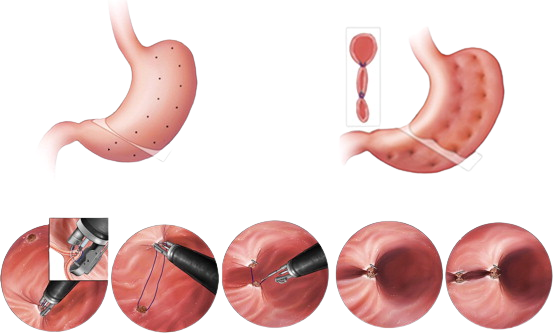Worldwide, more and more people are looking for efficient means of combating their weight issues. Endoscopic sleeve gastrectomy (ESG) has become a popular choice among weight loss surgeries because it is both safe and effective. This article will explain endoscopic sleeve gastrectomy, or ESG, and discuss its advantages, disadvantages, potential candidates, surgery, recuperation, aftercare, dangers, and comparisons to other weight reduction treatments.
What is Endoscopic Sleeve Gastroplasty (ESG)?
An alternative to traditional surgery for obesity, endoscopic sleeve gastrectomy is also known as the accordion operation. Unlike gastric bypass and sleeve gastrectomy, which both require abdominal incisions, ESG does not. Endoscopic procedures, in contrast, involve inserting a thin, flexible tube (endoscope) with a camera down a patient’s throat and into the stomach.
How Does ESG Work
During the ESG operation, the surgeon sutures the stomach from the inside to minimize its size, giving the stomach a sleeve form. This reduces the stomach’s capacity, making you feel full after eating a lesser amount. The technique also influences the synthesis of hunger hormones, leading to less hunger and enhanced fullness.
Benefits of Endoscopic Sleeve Gastroplasty
When compared to conventional weight-loss operations, ESG has many benefits. The lack of exterior incisions means less scars, less pain, and a quicker recovery period thanks to endoscopic surgery. For high-risk patients who aren’t good candidates for open operations, this method offers a safer alternative. Malabsorption and nutritional deficits are less likely to occur with ESG since the intestines are not redirected.
Who is a Suitable Candidate for ESG?
People who are obese (defined as a BMI of 30–40) may benefit greatly from ESG. Candidates who have not been successful losing weight with diet and exercise or who are hesitant to undergo conventional bariatric surgery may benefit from ESG. The only way to know for sure if you qualify is to have a thorough conversation with a trained medical expert who has conducted an evaluation.
Preparing for the ESG Procedure
Candidates will need to have a battery of medical tests run on them before they can have an ESG performed. The healthcare practitioner will examine the patient’s medical records, perform a physical examination, and provide the individual detailed instructions for getting ready for the treatment. Modifying one’s diet, taking different medications, or giving up smoking may all be part of these recommendations.
The Endoscopic Sleeve Gastroplasty Procedure
The ESG surgery might take anywhere from 60 minutes to 90 minutes, depending on the patient’s condition. The procedure is described in detail below.
- Anesthesia and Sedation: For the patient’s comfort and safety, general anesthesia or sedation will be delivered before the treatment begins.
- Insertion of the Endoscope: The surgeon is able to see within the stomach by inserting an endoscope through the mouth and esophagus.
- Suturing the Stomach: The surgeon will use endoscopic tools to cut away excess stomach tissue and then carefully put stitches along the stomach wall to form the sleeve.
Completion of the Procedure
The process concludes after the suturing is accomplished and the endoscope is removed.
Recovery and Aftercare
In order to recover from ESG and lose weight healthily, patients must adhere to a strict set of instructions. Diet, exercise, and medication management will all be addressed in great depth by the healthcare provider. Some doctors recommend that patients begin on a liquid diet and work their way up to soft foods before resuming solid foods.
Post-Procedure Diet
The post-op diet is essential for the stomach to heal and adjust to its new size. Small, nutrient-dense meals should be eaten several times a day, and patients should stay away from items that are high in calories and fat.
Follow-Up Visits
Follow-up appointments with a healthcare professional are crucial for checking in on a patient’s recovery, addressing any problems that may have arisen, and making sure the patient is doing well.
Potential Risks and Complications
The dangers of ESG are similar to those of any other medical operation. Immediate post-procedure problems include feeling nauseous or sick, having stomach pain, or having trouble swallowing. Suture-related complications, like leaks or bleeding, are possible, although uncommon. Serious side effects, however, are uncommon, and the majority of patients make a full recovery.
Comparison with Other Weight Loss Procedures
ESG is an attractive substitute for conventional bariatric surgery because it is less intrusive while producing similar weight loss outcomes. ESG has less side effects, less risk of infection, and quicker recovery than gastric bypass or sleeve gastrectomy.
Conclusion
Endoscopic sleeve gastrectomy is a novel and less invasive option for people who want to lose weight and keep it off. ESG has gained popularity as a treatment for obesity due to its many advantages, rapid recovery, and positive outcomes. It is important for anyone considering ESG to first talk to a doctor to make sure the surgery is appropriate for their needs and health status.
Frequently Ask Questions (FAQs)
What is the success rate of ESG?
Many patients have reported significant weight loss after using ESG, which is encouraging. When coupled with a healthy lifestyle, success rates can be rather remarkable, but they will naturally vary from person to person.
Can ESG be reversed?
In the case of emergency, ESG can be switched to other weight loss techniques, unlike permanent bariatric surgery. However, determinations of this nature are always made on a case-by-case basis.
How much weight can I expect to lose with ESG?
Individual factors like as starting weight, following post-procedure recommendations, and changing eating and exercise habits all affect the weight loss results. Patients may experience a weight loss of 30-50% on average.
Is ESG covered by insurance?
Whether or not ESG is included in your premiums depends on your specific policy and insurance provider. It is crucial to contact the insurance provider to verify coverage and eligibility.
Are there any dietary restrictions after ESG?
Dietary restrictions will be necessary after ESG for optimal health and weight loss. After surgery, patients will need to eat in accordance with their doctor’s orders.











